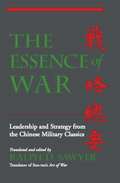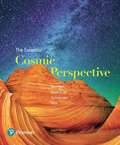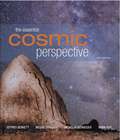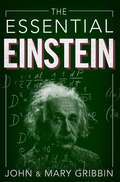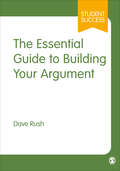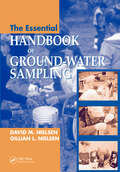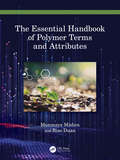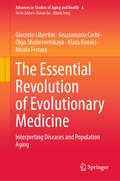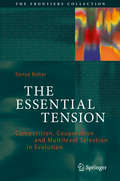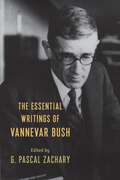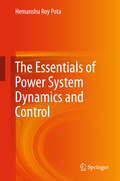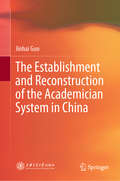- Table View
- List View
The Essence of Turbulence as a Physical Phenomenon: With Emphasis on Issues of Paradigmatic Nature
by Arkady TsinoberThis book critically reexamines what turbulence really is, from a fundamental point of view and based on observations from nature, laboratories, and direct numerical simulations. It includes critical assessments and a comparative analysis of the key developments, their evolution and failures, along with key misconceptions and outdated paradigms. The main emphasis is on conceptual and problematic aspects, physical phenomena, observations, misconceptions and unresolved issues rather than on conventional formalistic aspects, models, etc. Apart from the obvious fundamental importance of turbulent flows, this emphasis stems from the basic premise that without corresponding progress in fundamental aspects there is little chance for progress in applications such as drag reduction, mixing, control and modeling of turbulence. More generally, there is also a desperate need to grasp the physical fundamentals of the technological processes in which turbulence plays a central role.
The Essence of War: Leadership and Strategy from the Chinese Military Classics
by Ralph D. SawyerFrom antiquity, the history of China has been marked by invading tribes, warring states, and popular uprisings. This heritage of conflict produced a body of martial literature exploring the fundamental principles of warfare and their methods of employment. Fully aware of the tragic consequences of battle, the authors of these texts emphasized that bloodshed and war should be avoided whenever possible. But, they argued, this is possible only when the principles of leadership and strategy have been mastered and the dynamics of conflict thoroughly analyzed. Over the centuries, these texts have been studied throughout Asia, not only by generals on the battlefield but by leaders of all kinds concerned with the management of human conflict in all its forms. The Essence of War presents eight of these classics (written from 500 B. C. E. to 700 C. E. ), including Sun-tzu's Art of War and Sun Pin's Military Methods. The book introduces the core principles of Chinese military science, grouping selected passages and key quotations into five thematic sections encompassing forty-one topical chapters: Fundamentals, Tao of Warfare, Tao of Command, Tactical Essentials, and Tactical Specifics. Translator Ralph D. Sawyer provides here a concise introduction to Chinese military thought and influential materials not only of traditional import, but also for contemporary study and enduring value in both business and military circles throughout the world.
The Essential Book of Fermentation
by Jeff CoxThe country's leading expert on organic food delivers the ultimate guide to the new culinary health movement--feasting on fermented probiotics, from artisanal cheese to kimchi. In his extensive career as a bestselling cookbook author and TV garden-show host, Jeff Cox has always been keenly aware of the microbiology that helps his garden flourish. He has long known that microbes keep our bodies healthy as they ferment food, releasing their nutritional power and creating essential vitamins and enzymes. In The Essential Book of Fermentation, Cox shares a bounty of recipes for nourishing the internal "garden." Simplifying the art and science of fermentation, Cox offers a primer on the body's microbial ecosystem, complemented by scrumptious recipes, and easy-to-follow pickling and canning techniques. Basics such as bread and yogurt help readers progress to wine, cheese, and a host of international delicacies, including kim chi and chow chow. Inspiring and innovative, The Essential Book of Fermentation serves up great taste along with great health on every page.
The Essential Cosmic Perspective
by Jeffrey Bennett Mark Voit Nicholas Schneider Megan Donahue<P><P>A practical introduction to Astronomy with an emphasis on critical thinking about our place in the universe <P><P>This 8th Edition of Essential Cosmic Perspective provides readers without science backgrounds with a streamlined, cutting-edge introduction to astronomy. Built on a strong tradition of effective pedagogy and coverage, the text focuses on skill-building and includes group work exercises that require active participation. Dedicated to bringing an understanding of the universe, its scientific basis and its relevance to our lives, each chapter is written to specific learning goals that build an ideal learning path for readers. Aiming to foster a lifelong learning experience, the authors focus on key concepts, providing big picture context, promoting conceptual understanding, and preferring plain language to jargon. <P><P>The 8th Edition incorporates the latest scientific updates in the field of astronomy and includes new features that reinforce critical thinking and excite readers’ curiosity. New features such as Extraordinary Claims engage readers by presenting extraordinary claims about the universe and how they were either supported or debunked as scientists collected more evidence, reinforcing the process of science and how scientists think critically to evaluate them. My Cosmic Perspective establishes a personal connection between readers and the cosmos as they learn to think critically about the meaning of what they learn in their astronomy studies and beyond. Designed and written for a one semester course, this text shares many of the strengths of its more comprehensive best-selling sibling, The Cosmic Perspective.
The Essential Cosmic Perspective
by Jeffrey O. Bennett Mark Voit Nicholas Schneider Megan Donahue<p>The Essential Cosmic Perspective is designed as a textbook for college courses in introductory astronomy, but is suitable for any¬one who is curious about the universe. We assume no prior knowledge of astronomy or physics, and the book is especially written for students who do not intend to major in mathematics or science. <p>We have tailored The Essential Cosmic Perspective to one-semester survey courses in astronomy by carefully selecting the most important topics and presenting them with only as much depth as can be realistically learned in one semester. This book may also be used for two-semester astronomy sequences, though instructors of such courses may wish to consider our more comprehensive book, The Cosmic Perspective.</p>
The Essential Einstein
by John Gribbin Mary GribbinThe definitive scientific icon of the twentieth century, Albert Einstein is remember for one equation, E=mc², and the image of a white-haired, pipe-smoking professor who didn?t wear socks. But the equation comes from a time when all of his great work was done. The real Albert Einstein ? the high school drop-out who won the Nobel Prize along with the hearts of so many young women ? was young, handsome, dark haired and a natty dresser. And his greatest piece of work was so poorly understood at the time that the Nobel Committee, who couldn?t understand it, but in a panic felt they ought to give him a prize for something, honoured him for something else. An introduction, afterword and clear chronological table place Einstein?s work in the context of the development of scientific knowledge.
The Essential Einstein
by John Gribbin Mary GribbinThe definitive scientific icon of the twentieth century, Albert Einstein is remember for one equation, E=mc², and the image of a white-haired, pipe-smoking professor who didn’t wear socks. But the equation comes from a time when all of his great work was done. The real Albert Einstein – the high school drop-out who won the Nobel Prize along with the hearts of so many young women – was young, handsome, dark haired and a natty dresser. And his greatest piece of work was so poorly understood at the time that the Nobel Committee, who couldn’t understand it, but in a panic felt they ought to give him a prize for something, honoured him for something else. An introduction, afterword and clear chronological table place Einstein’s work in the context of the development of scientific knowledge.
The Essential Engineer: Why Science Alone Will Not Solve Our Global Problems
by Henry PetroskiFrom the acclaimed author of The Pencil and To Engineer Is Human, The Essential Engineer is an eye-opening exploration of the ways in which science and engineering must work together to address our world&’s most pressing issues, from dealing with climate change and the prevention of natural disasters to the development of efficient automobiles and the search for renewable energy sources. While the scientist may identify problems, it falls to the engineer to solve them. It is the inherent practicality of engineering, which takes into account structural, economic, environmental, and other factors that science often does not consider, that makes engineering vital to answering our most urgent concerns.Henry Petroski takes us inside the research, development, and debates surrounding the most critical challenges of our time, exploring the feasibility of biofuels, the progress of battery-operated cars, and the question of nuclear power. He gives us an in-depth investigation of the various options for renewable energy—among them solar, wind, tidal, and ethanol—explaining the benefits and risks of each. Will windmills soon populate our landscape the way they did in previous centuries? Will synthetic trees, said to be more efficient at absorbing harmful carbon dioxide than real trees, soon dot our prairies? Will we construct a &“sunshade&” in outer space to protect ourselves from dangerous rays? In many cases, the technology already exists. What&’s needed is not so much invention as engineering.Just as the great achievements of centuries past—the steamship, the airplane, the moon landing—once seemed beyond reach, the solutions to the twenty-first century&’s problems await only a similar coordination of science and engineering. Eloquently reasoned and written, The Essential Engineer identifies and illuminates these problems—and, above all, sets out a course for putting ideas into action.
The Essential Galileo
by John Gribbin Mary GribbinGalileo Galilei (1564-1642) was the first scientist in the modern use of the term. Instead of relying on the works of Aristotle, he actually carried out experiments to test theories ? legend has it that one of his experiments involved throwing weights off the Leaning Tower of Pisa. His astronomical observations with the telescope shattered the idea that the Earth was at the centre of the Universe, and led to his trial for heresy. He had a great lust for life, three children by a woman he never married, a biting, sarcastic with and the friendship of princes and (in spite of his run in with Pope Urban VIII) cardinals. An introduction, afterword and clear chronological table place Galileo?s work in the context of the development of scientific knowledge.
The Essential Galileo
by John Gribbin Mary GribbinGalileo Galilei (1564-1642) was the first scientist in the modern use of the term. Instead of relying on the works of Aristotle, he actually carried out experiments to test theories – legend has it that one of his experiments involved throwing weights off the Leaning Tower of Pisa. His astronomical observations with the telescope shattered the idea that the Earth was at the centre of the Universe, and led to his trial for heresy. He had a great lust for life, three children by a woman he never married, a biting, sarcastic with and the friendship of princes and (in spite of his run in with Pope Urban VIII) cardinals. An introduction, afterword and clear chronological table place Galileo’s work in the context of the development of scientific knowledge.
The Essential Guide to Building Your Argument (Student Success)
by Dave RushStruggling to know why arguments are important at university? Unsure about what an argument is, how they work, or how to produce one? Then you have come to the right place! Covering both written and verbal arguments, this practical guide will demystify academic conventions. It will show you what an argument is and how it works, providing you with a framework for producing great arguments of your own. Student Success is a series of essential guides for students of all levels. From how to think critically and write great essays to boosting your employability and managing your wellbeing, the Student Success series helps you study smarter and get the best from your time at university.
The Essential Guide to Building Your Argument (Student Success)
by Dave RushStruggling to know why arguments are important at university? Unsure about what an argument is, how they work, or how to produce one? Then you have come to the right place! Covering both written and verbal arguments, this practical guide will demystify academic conventions. It will show you what an argument is and how it works, providing you with a framework for producing great arguments of your own. Student Success is a series of essential guides for students of all levels. From how to think critically and write great essays to boosting your employability and managing your wellbeing, the Student Success series helps you study smarter and get the best from your time at university.
The Essential Handbook of Ground-Water Sampling
by David M. Nielsen Gillian NielsenTremendous improvements in ground-water sampling methodologies and analytical technologies have made it possible to collect and analyze truly representative samples to detect increasingly lower levels of contaminants-now in the sub-parts-per-billion range. Though these new methods produce more accurate and precise data and are less expensive, many
The Essential Handbook of Polymer Terms and Attributes
by Biao Duan Munmaya K MishraThe Essential Handbook of Polymer Terms and Attributes not only acts as an encyclopaedia of polymer science but also fosters an appreciation for the significance of polymers in fields including materials science, chemistry, engineering, and medicine. This book serves as an excellent reference book, covering every possible term and attribution associated with the vast and diverse field of polymers. This comprehensive volume serves as a vital resource for researchers working in industry and academia, offering a clear and concise exploration of polymer science with the most essential reference data available. Each polymer term is defined in a straightforward manner, ensuring that readers of all levels can grasp the concepts. The book goes beyond mere definitions, providing context and insights into the applications, properties, and synthesis. Bringing polymer terms and attributes together in one place, the book provides a broad knowledge of polymer science and facilitates idea generation for researchers and students embarking on projects related to a specific field of polymer science. Key features: This book covers all possible terms associated with the field of “polymers" and related areas, granting readers a comprehensive understanding of the entire spectrum of polymers. The organization of the book follows an alphabetical format, enabling quick and convenient access to specific terms. Each polymer term is clearly defined with a figure or scheme as needed, allowing readers to visualize the structures, processes, and applications involved. This book is written for science students, chemists, polymer scientists, chemical engineers, pharmaceutical scientists, biomedical scientists, biotechnologists, product formulators, materials scientists, and scientists working on polymers.
The Essential Revolution of Evolutionary Medicine: Interpreting Diseases and Population Aging (Advances in Studies of Aging and Health #4)
by Giacinto Libertini Graziamaria Corbi Olga Shubernetskaya Nicola Ferrara Klara KomiciThis book proposes a way to radically renew medicine by extending to medicine the concepts of evolutionary biology. The book considers diseases not as unpredictable harmful events but as logical consequences of evolutionary mechanisms. In particular, a large part of the most widespread diseases that afflict modern populations are interpreted as the consequence of discordances (mismatches) between new living conditions and the adaptation of our species. It discusses the basic concepts, as well as diseases deriving from alterations of the genotype and general concepts about diseases deriving from alterations of the ecological niche. It also describes diseases deriving from relations with other living beings especially when the ecological niche is altered, diseases deriving from conditions beyond the adaptation range, and physiological phenomena that cause troubles and suffering or even death. A particular study is dedicated to the interpretation of aging and its consequences in normal or altered conditions of the ecological niche. The final part of the book describes the implementation of evolutionary medicine. This book, complementing the "Evolutionary Gerontology and Geriatrics" book, which is also published in this series, provides a valuable read for scholars and students in the fields of medicine, evolutionary biology, preventive medicine, and gerontology.
The Essential Tension
by Sonya Bahar'The Essential Tension' explores how agents that naturally compete come to act together as a group. The author argues that the controversial concept of multilevel selection is essential to biological evolution, a proposition set to stimulate new debate. The idea of one collective unit emerging from the cooperative interactions of its constituent (and mutually competitive) parts has its roots in the ancient world. More recently, it has illuminated studies of animal behavior, and played a controversial role in evolutionary biology. In Part I, the author explores the historical development of the idea of a collectivity in biological systems, from early speculations on the sociology of human crowd behavior, through the mid-twentieth century debates over the role of group selection in evolution, to the notion of the selfish gene. Part II investigates the balance between competition and cooperation in a range of contemporary biological problems, from flocking and swarming to experimental evolution and the evolution of multicellularity. Part III addresses experimental studies of cooperation and competition, as well as controversial ideas such as the evolution of evolvability and Stephen Jay Gould's suggestion that "spandrels" at one level of selection serve as possible sources of variability for the next higher level. Finally, building on the foundation established in the preceding chapters, the author arrives at a provocative new proposition: as a result of the essential tension between competition and cooperation, multiple levels may be essential in order for evolutionary processes to occur at all.
The Essential Tension: Selected Studies in Scientific Tradition and Change
by Thomas S. Kuhn"Kuhn has the unmistakable address of a man, who, so far from wanting to score points, is anxious above all else to get at the truth of matters."—Sir Peter Medawar, Nature
The Essential Writings of Vannevar Bush
by Vannevar BushThe influence of Vannevar Bush on the history and institutions of twentieth-century American science and technology is staggeringly vast. As a leading figure in the creation of the National Science Foundation, the organizer of the Manhattan Project, and an adviser to Presidents Roosevelt and Truman during and after World War II, he played an indispensable role in the mobilization of scientific innovation for a changing world. A polymath, Bush was a cofounder of Raytheon, a pioneer of computing technology, and a visionary who foresaw the personal computer and might have coined the term “web.”Edited by Bush’s biographer, G. Pascal Zachary, this collection presents more than fifty of Bush’s most important works across four decades. His subjects are as varied as his professional pursuits. Here are his thoughts on the management of innovation, the politics of science, research and national security, technology in public life, and the relationship of scientific advancement to human flourishing. It includes his landmark introduction to Science, the Endless Frontier, the blueprint for how government should support research and development, and much more. The works are as illuminating as they are prescient, from considerations of civil-military relations and the perils of the nuclear arms race to future encyclopedias and information overload, the Apollo program, and computing and consciousness. Together, these pieces reveal Bush as a major figure in the history of science, computerization, and technological development and a prophet of the information age.
The Essentials of Clinical Dialysis
by Yong-Lim Kim Hideki KawanishiThisbook is a thorough guide to dialysis that will assist in the effectivetreatment of patients. Current knowledge on all aspects of dialysis, includingthe most recent advances, is presented and the various techniques used indialysis patients are described step by step. Both hemodialysis and peritonealdialysis are fully considered. The coverage of hemodialysis explains theprocedure and its indications and provides guidance on challenging topics suchas vascular access, response to acute and chronic complications, and on-linehemodiafiltration. The discussion of peritoneal dialysis includes explanation ofperitoneal physiology, the principles of prescription, and the treatment ofperitonitis and exit site infection. A summary of updated dialysis-relatedguidelines is included at the end of the book. The lucid text is supported bymore than 200 full-color illustrations that clarify anatomy,vascular/peritoneal access, and dialysis procedures and techniques. The Essentialsof Clinical Dialysis will be of value for all who are involvedin the management of dialysis patients and will be a helpful guide for trainingof physicians and healthcare associates in the dialysis center.
The Essentials of Power System Dynamics and Control
by Hemanshu Roy PotaThis book presents a general framework for modelling power system devices to develop complete electromechanical models for synchronous machines, induction machines, and power electronic devices. It also presents linear system analysis tools that are specific to power systems and which are not generally taught in undergraduate linear system courses. Lastly, the book covers the application of the models, analysis and tools to the design of automatic voltage controllers and power system stabilisers, both for single-machine-infinite-bus systems and multi-machine interconnected systems.In most textbooks modelling, dynamic analysis, and control are closely linked to the computation methods used for analysis and design. In contrast, this book separates the essential principles and the computational methods used for power system dynamics and control. The clear distinction between principles and methods makes the potentially daunting task of designing controllers for power systems much easier to approach.A rich set of exercises is also included, and represents an integral part of the book. Students can immediately apply—using any computational tool or software—the essential principles discussed here to practical problems, helping them master the essentials.
The Essentials of Thermodynamics (Physical Chemistry in Action)
by Miloslav PekařThis monograph offers a unique approach to understanding thermodynamics by blending practical experience, a mathematically rigorous foundation, and historical insights. It presents the evolution of thermodynamics, demonstrating that the functions, equations, relationships, and quantities didn't simply materialize but were rooted in the human experience of heat and cold. While equilibrium thermodynamics is the primary focus, time is integrated as a fundamental element, distinguishing this from traditional treatments. Readers will find familiar heat-related experiences transformed into model equations, revealing the natural emergence of fundamental thermodynamic concepts. These essentials are then distilled into simple axioms summarizing the core principles of equilibrium thermodynamics. The book goes beyond macroscopic descriptions, delving into microscopic connections at the atomic and molecular levels. It is suitable for a diverse readership, including students in science and technology, professionals looking to refresh their knowledge of thermodynamics, and those interested in exploring advanced, non-equilibrium thermodynamics. While it caters to a broad audience, it is particularly beneficial for individuals in chemistry and chemical engineering, requiring only a basic understanding of calculus.
The Establishment and Reconstruction of the Academician System in China
by Jinhai GuoThis book is the first monograph to study the processes of establishing and reconstructing the academician system, and the landmark events in the history of science and technology in 20th century China. It also provides new insights to help us understand the process of scientific institutionalization in modern China. Drawing on detailed archive records, it discusses the process of the establishment of the Academia Sinica's academician system in the Republic of China, as well as the unique and tortuous transformation process from members of the Academic Divisions(学部委员)to academicians of the Chinese Academy of Sciences(中国科学院)in the People's Republic of China. These play an important part of China's modernization process, and reflect scientific institutionalization in China. The book also highlights the fact that under the leadership of the government, the academic elite became participants in the construction of national academic system after the founding of the People's Republic of China.
The Estrogen Elixir: A History of Hormone Replacement Therapy in America
by Elizabeth Siegel WatkinsIn the first complete history of hormone replacement therapy (HRT), Elizabeth Siegel Watkins illuminates the complex and changing relationship between the medical treatment of menopause and cultural conceptions of aging. Describing the development, spread, and shifting role of HRT in America from the early twentieth century to the present, Watkins explores how the interplay between science and society shaped the dissemination and reception of HRT and how the medicalization—and subsequent efforts toward the demedicalization—of menopause and aging affected the role of estrogen as a medical therapy. Telling the story from multiple perspectives—physicians, pharmaceutical manufacturers, government regulators, feminist health activists, and the media, as well as women as patients and consumers—she reveals the striking parallels between estrogen’s history as a medical therapy and broad shifts in the role of medicine in an aging society.Today, information about HRT is almost always accompanied by a laundry list of health risks. While physicians and pharmaceutical companies have striven to develop the safest possible treatment for the symptoms of menopause and aging, many specialists question whether HRT should be prescribed at all. Drawing from a wide range of scholarly research, archival records, and interviews, The Estrogen Elixir provides valuable historical context for one of the most pressing debates in contemporary medicine.
The Ethereal Aether: A History of the Michelson-Morley-Miller Aether-Drift Experiments, 1880-1930
by Loyd S. SwensonThe Ethereal Aether is a historical narrative of one of the great experiments in modern physical science. The fame of the 1887 Michelson-Morley aether-drift test on the relative motion of the earth and the luminiferous aether derives largely from the role it is popularly supposed to have played in the origins, and later in the justification, of Albert Einstein's first theory of relativity; its importance is its own. As a case history of the intermittent performance of an experiment in physical optics from 1880 to 1930 and of the men whose work it was, this study describes chronologically the conception, experimental design, first trials, repetitions, influence on physical theory, and eventual climax of the optical experiment. Michelson, Morley, and their colleague Miller were the prime actors in this half-century drama of confrontation between experimental and theoretical physics. The issue concerned the relative motion of "Spaceship Earth" and the Universe, as measured against the background of a luminiferous medium supposedly filling all interstellar space. At stake, it seemed, were the phenomena of astronomical aberration, the wave theory of light, and the Newtonian concepts of absolute space and time. James Clerk Maxwell's suggestion for a test of his electromagnetic theory was translated by Michelson into an experimental design in 1881, redesigned and reaffirmed as a null result with Morley in 1887, thereafter modified and partially repeated by Morley and Miller, finally completed in 1926 by Miller alone, then by Michelson's team again in the late 1920s. Meanwhile Helmholtz, Kelvin, Rayleigh, FitzGerald, Lodge, Larmor, Lorentz, and Poincaré-most of the great names in theoretical physics at the turn of the twentieth century-had wrestled with the anomaly presented by Michelson's experiment. As the relativity and quantum theories matured, wave-particle duality was accepted by a new generation of physicists. The aether-drift tests disproved the old and verified the new theories of light and electromagnetism. By 1930 they seemed to explain Einstein, relativity, and space-time. But in historical fact, the aether died only with its believers.

